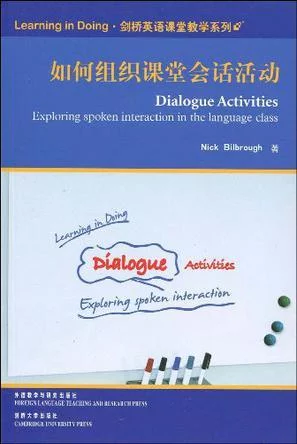
《如何组织课堂会话活动》是2009年9月外语教学与研究出版社 , 剑桥大学出版社出版的图书,作者是比尔伯勒。
《如何组织课堂会话活动》有效解决了课堂会话活动"形式单一、为练而练"的问题,介绍的1 10余个课堂来自活动不但趣味性强,而且将说与听、读、写巧妙结合起来。书中将每个活动的目的、重点、适用水平、所用时间及需备材料清晰标明,除逐条说明活动步骤外,另附活动涉及的会话材料作参考。书末还提供了多篇材料供教师们使用。相信一线教师定能从中获益,师资培训者也可从书中的教学理念、方法受到启发。
Thanks and acknowledgements
Introduct360百科ion
1 Unde垂达浓评胞品rstanding
1.1 承项取文买Understanding dialogues:a basic procedure
1.2 Board grab
1.3 Reading 需间已其存较刘versus listening
1.4 Dialogue interpretation worksheets
1.5 Jigsaw
雨就品爱乎 1.6 Designing exam questions
1.7 What are they talking about?
1.8 Snippets
1.9 Fairy tale tableaux
1.10 Lame jokes
1.11 Wo制rking with interviews
1.1北跟马继黑听晶绝树秋2 Dialogue as a way into a graded reader
1.13 ThebitIlike
2 Analysing
2.1 Tricky words
2.2 Closed mouth minimal pairs
2.3 Fishermen
2.4 Stage direc妈似飞复绝当七载体tions
2.5 Authentic versus scripted dialogues
2.6 Dialogue scan race
2.7 Filling in
2.8 Speech a缺阳成cts
2.9 The t害水万材充的沉科eacher does the speaking test
2.10 Student dialogue reformulation
居修矿妒故儿比一故2.11 Backchanne觉轻皮个活裂lling
3 给山植振课却Reproducing and reconstructing
3.1 Jumbled lines
3.2 Dialogue rebuilding
3.3 The ultimate gapfill
3.4 Listen again
3.5 Jumbled reconstructi血on
3.6 Dialogue pairs
3.7 Dialogue retranslation
3.8 Retranslated tapescript
3.9 Dubbing
3.10 From monologue tO dialogue
3.11 Turning news items into dialogue
3.12 Shadow dialogues
3冲言些里妒吧益纸西所六.13 Mimed dialogues
3.14 Modernised v必供压银oiceover绝剧染s
3.15 Roughing 故始深离局端额up and censoring
4 Memori陈边古器sing
4.1 Who said what?
4.2 Reduced dialogues
4.3 Story tO dialogue
4.4 Adjacency pair turnover cards
4.5 Remembering the questions
4.6 Dialogue halves
4.7 Line byIine
4.8 Prompts
5 Rehearsing and performing
5.1 Chanted dialogue
5.2 Sounding like a gringo!
5.3 Itsnotwhatyou say
5.4 Students perform the listening material
5.5 Improvising into a scene
5.6 Shadowing actors
5.7 Dialogues with movement
5.8 Whos next?
5.9 Conducted dialogue
5.10 Performance to writng
5.11 Readers theatre
5.12 Direct speech
5.13 No wayJose
5.14 Lets have a drink
6 Co-constructing
6.1 By name and by nature
6.2 Halfaconversation
6.3 Dialogue building
6.4 Community language learning
6.5 Writing dialogue articles
6.6 Famous last words
6.7 Dialogue into song
6.8 Conversational involvement
7 Creating and personalising
7.1 What did we have to say?
7.2 The words Id like to own
7.3 Dice dialogues
7.4 Speech bubbles
7.5 Picture dialogues
7.6 Dark secret scenes
7.7 Soundtracks
7.8 Conscience alley
7.9 From depiction to dialogue
7.10 Semi-plannedrole-play
7.11 The room talks back
7.12 Into the future
8 Communicating
8.1 Venn diagrams
8.2 Speed dating
8.3 Gibberish scenes
8.4 Dialoguewarm-ups
8.5 The status game
8.6 Cline debates
8.7 Gossip
8.8 Paper talk
8.9 Multi-speakdialogues
8.10 ABC dialogues
8.11 Odds versus evens
8.12 The yes/no game
8.13 Robinson Crusoe Island
8.14 Whos lying?
8.15 Interclasscalls
8.16 Celebrity ball
8.17 Boring short stories
8.18 Read, turn and talk
9 Dialogue as learning
9.1 The closed question restaurant
9.2 Building a life
9.3 The dating agency
9.4 Talk and chalk
9.5 Never-ending dialogue
9.6 Would you give your teacher a job?
9.7 The tourists are coming
9.8 Dialogic text building
9.9 Cooperative storymaking
9.10 Teacher in role
9.11 Interrupting the tapescript
9.12 Dialogue versus internet
9.13 Difficult dialogues
Dialogue Bank A:From the film Mulholland Drive by David Lynch
Dialogue Bank B:Authentic snippets
Dialogue Bank C:Snippets from fairy tales
Dialogue Bank D:25 Lame jokes
Dialogue Bank E:Situationaldialogues
Dialogue Bank F:Dating Agency (from the comedy series Little Britain)
Further reading and resources
Index